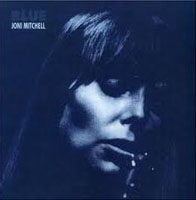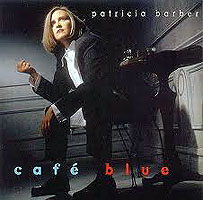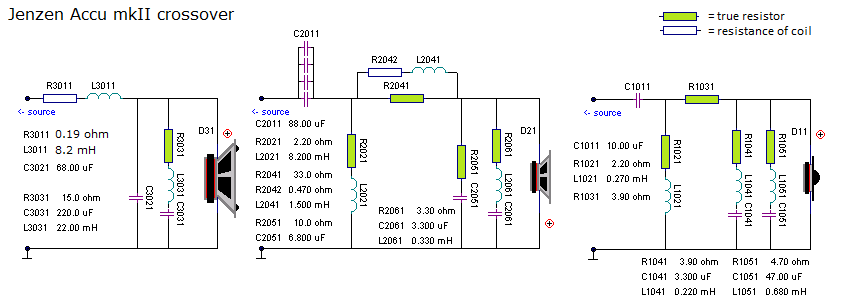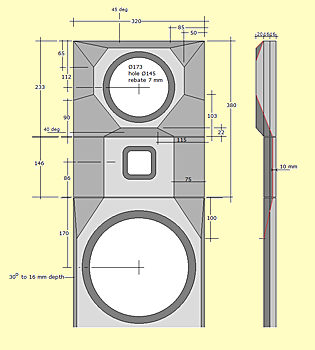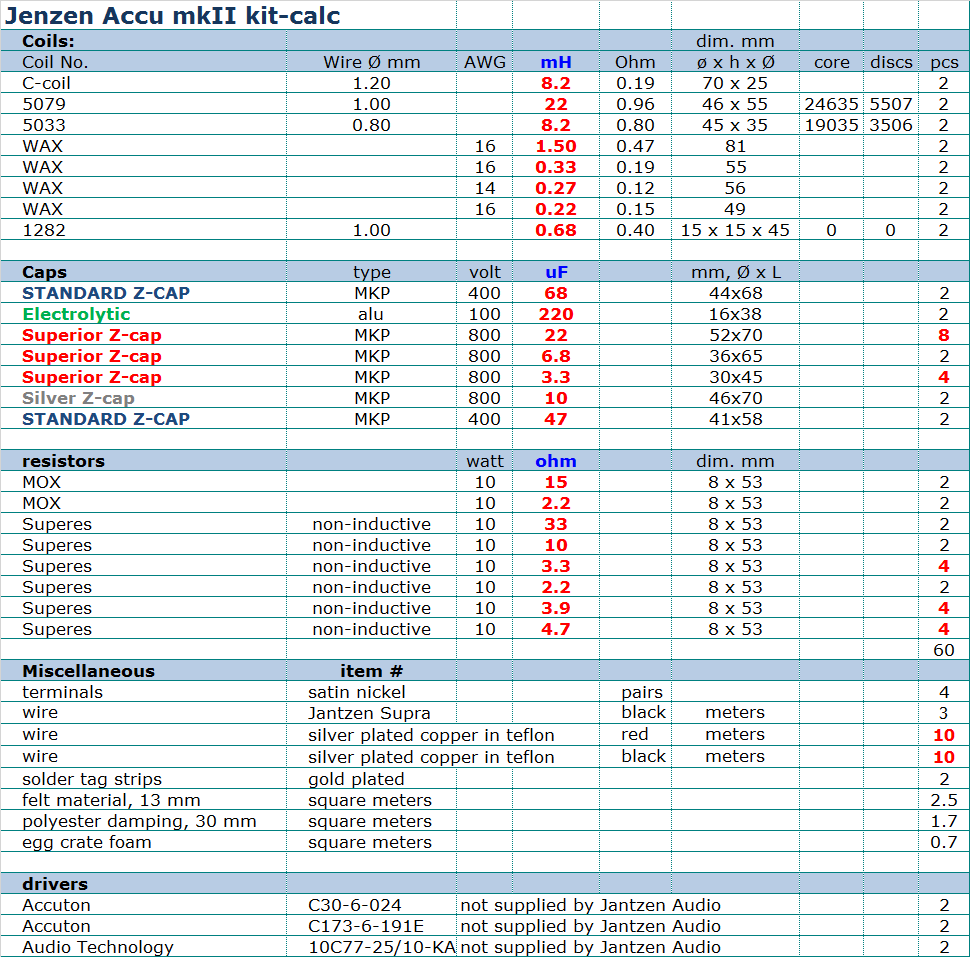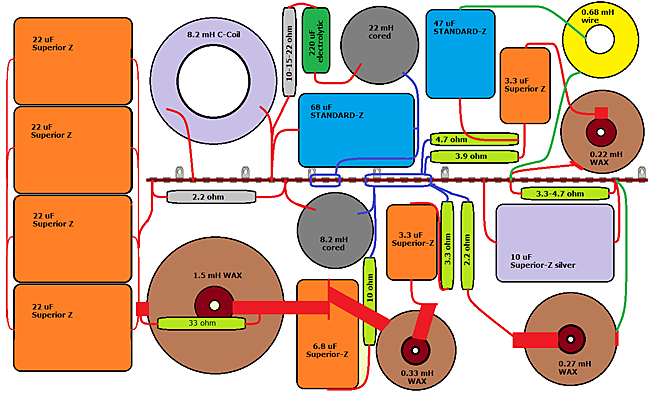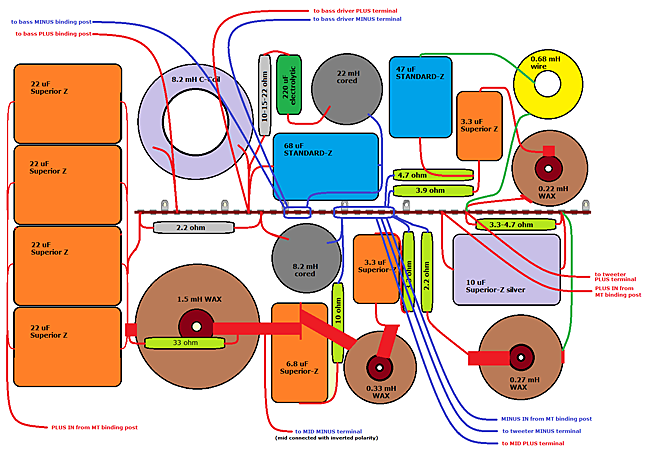|
Jenzen Accu mkII The Drivers The Sound Crossover Cabinet Measurements Crossover Layout Crossover Kit The Jenzen Accu mkII
features the front panel from the Jenzen
D and a slightly modified tweeter crossover. Everything else is
the same as first launch.
All loudspeaker drivers hold a sonic signature
depending on overall construction and components used, not least cone
materials. Making a blend of sounds from very different
cone materials may not always perform well regardless of how well we
implement the crossover.
I
often had trouble
making a good blend of true alu ribbon tweeters and a midrange driver,
regardless of the latter's soft or hard cone. Lack of uniform
dispersion may be one problem, but the sonic signature of
ribbons is special.
The law of diminishing return goes
for high-end speakers as for economics in productivity of consumer
goods. We may throw in a diamond tweeter, but we can't be sure the
bottleneck is not somewhere else and further investments just doesn't pay off in terms of
improved sound.
The Accuton drivers fitted
with ceramic cones are considered some of the best transducers around. The
rigid cones display pistonic motion within their operating range, but
break up when we reach higher frequences, e.g. 4-5 kHz for a
6" driver. To dampen the ringing several options are available:
Do nothing and filter out the notches, add damping polymers to the
cones, punch holes or "ears" in the diaphragm (and seal them again), etc.
Whatever we do, the ringing of true hard cones will have an impact on
the sound that emanates from the speaker. The trick is to get the
resonances as far out of its operating range as possible and to get
them some 15-20 dB below output level.
Having a low point of
crossover between bass and mid (~200Hz) I wasn't too concerned about
compatibility between bass and mid. These are both hard cone drivers
and should mate well, and so they did. Should the Jenzen Accu catch your attention and should you want to replace any of the specified drivers, please DO NOT ask if this or that driver is suitable. I can't tell and I won't speculate on replacements based on driver specs. Thank you!
Buying Accuton C30-6-024 tweeters I had other projects in mind, but while working on Jenzen SEAS speakers, I couldn't help wonder what would become of a Jenzen Accuton set-up. Having received the Accuton tweeters I quickly did some measurements and based on modelling this tweeter appeared an easy implementation in a range of 2- and 3-ways. Thus, the search for an Accuton* midbass driver started. For the time being (2011) Accuton faces the problem of neodymium prices reaching the skies and their neo drivers have to be redesigned to fully utilise smaller neo magnets - or using ceramic magnets. I don't fancy any particular magnet material over another and I don't think anyone ever compared exactly identical drivers with either alnico, ceramic or neodym magnets. Preferences are most likely due to other design features. *: I was also looking at the Morel SCM634 having heard from Eggleston speakers what they can do, but the more I looked at the C173-6-191E, the more convinced I was that this was the driver to look for in this project. The SCM634 is even more expensive (320 €/ea) than the Accuton.
I
hope the Accuton C173-6-191E midbass driver will stay consistent in
the Accuton program for years to come.
Developing a speaker based on drivers that are out of stock next
year is no fun! The present C173-6-191E is a development of C173-6-195E. Comparing the two drivers we find Mms to be reduced by
1.7 grams, Qms slightly increased, hence Qt increased from 0.27
to 0.32. Cms has decreased from 1.35 to 1.20 and Sd increased from 130
to 132 cm2. Efficiency
appears slightly improved as expected from lower mass. That's all.
This mostly sounds like a new rubber surround, but there may be
changes to rear coating as well, because this cone does have a
coating on the rear side.
Audio Technology 10C77-25-10-KAP
bass driver has been reported in detail here.
Not much to add except that in its category*,
this is the best 10" bass driver I've had: Fairly efficient, easy on crossovers, a punchy performer with
low-level detail (high Qm) and only bad thing I can think of is
weight... In a well constructed enclosure it breaks my back from moving speakers
around from its 10 kg added weight.
* I reckon this driver in the family of mid-efficiency bass drivers. A 10 inch high-efficiency bass driver like the Eminence Deltalite II 2510 in a well-constructed horn will - to my ears - outperform the 10C77 with regard to transient response, and low-end extension is only a matter of horn properties. The price to pay is size. If it has to be small the 10C77 is the driver to look for and the price to pay is decent power amps that can handle the current needed. The Jenzen Accu mkII
Setting up loudspeakers can
become boring! Regardless of how the paper pulp or polyprop is used, we may have an idea of how this or that speaker is going to
perform - and so they mostly do. Not quite so with these Accuton drivers.
Getting the
midrange and tweeter level right took much longer than anticipated and
points
of crossover from 1.8-3.0 kHz were tried. Taking the point of
crossover really low first of all confirmed the C30 can go
really low, but on-axis response had to be recessed in the 2-5 kHz
range to balance the wide dispersion. This was bit like the Chario speaker
crossing over at 1.5 kHz and voiced to have a recessed on-axis
response in the 2-5 kHz range. On paper this may look bad, but in
reality provides a good balance between basic notes and overtones. If
dispersion in this frequency range is wide we have a lot of energy projected
into the room and we may have to attenuate a decibel or two to render
a perceived "flat" response. In reality this also depends on
room conditions and why some speakers may sound good in an
acoustically lively room and in other rooms not. As a speaker designer
this is an inevitable compromise to be considered. Most living rooms
are less than ideal for sound reproduction and how do we voice a
speaker to suit an average of living room acoustics? Not easy.
The soundstage
depth these drivers can
present is
astonishing. I couldn't help thinking of the Mangers
I did in between the Jenzen NEXT and Jenzen Accu. We could make a
2-way from these two Accuton drivers that would forever put the
Mangers on the shelf. And by the way: Running the C173 fullrange
without high-pass filter suggested a strong and solid bass
response even from the progressively stuffed TL mid cab. Material for
a small vented two-way monitor some day.... I can't help pointing to the distortion measurements shown below. This is the lowest distortion levels I have ever measured from a loudspeaker. At 5.6 volts input equivalent to ~94-95 dB at 1 meter, the total harmonic distortion is below 0.5% from 1000-20000 Hz and below 1% down to 400 Hz. Amazing! No wonder these drivers deliver an unprecedented level of transparency and resolution. Every evening during development I went to the workshop to hear another CD from my collection. One day the Getz/Gilberto CD. Although it had been a long time since last hearing, I didn't recall it sounding like this before.
It sounded ruthlessly
naked, not as lush and colourful as I remember it. The shortcomings of
the recording is clearly audible in terms of inadequate microphone
placement and the semi-stereo recording and mixing. Getz' handling of
his mouthpiece is clear as ever and the Accutons put you closer to the
event than most other speakers will do.
So, what are the limitations of
the Jenzen Accu? Considering the overall cost there shouldn't be any
shortcomings at all. Well, there are and the bottleneck is size if we
play really loud. Playing the
Stan Getz Cafe Montmartre track two, "I thought about
you", at loud level - like sitting 3rd row, the sax solos may
become compressed as we approach a sound level exceeding the capability
of the midrange driver. Hmm...I took the CD to
our living room and played the same track on the DTQWTs with their
8" middrivers and despite a slightly reduced sense of soundstage
depth, they reproduce these solos at ear-shredding levels without problems.
Size matters. I'm reluctant to put this "on paper" as it may
turn off someone who would otherwise be highly satisfied with the
design.
I often play John Campbell's Down in the Hole as a start for first time DTQWT visitors. Then we're kind of clear on bass performance and ability to play a rough vocal presentation at loud level. From here we can go on exploring more subtle features. So, can the Jenzen Accu do this track at loud level? It can. I'm only adding this example to emphasize that every speaker has its strengths and weaknesses - and to balance the statements made above. The Accuton drivers will time after time make you wonder if what you've heard before is really what it should sound like. Not that the Accutons are right, only a possible reference of neutrality. They will be my reference speakers for evaluating transparency and low distortion.
I know some people are fed up with references to this recording, but it's still an excellent example of spatial information. I can assure the C173/C30 drivers more than ever will make you want to reach out for the beer glass on the bar. I recently bid on mint condition Pawnshop LPs from the Eighties and they went up to 300 USD. I got them and they were worth the price. They clearly tell what happens to LPs when they've been played several hundred times, they loose micro detail and the soundstage depth is reduced.
Above my most likely
two desert island LPs. I have a reserve copy of Still Live when
current pressing gets too warn.
Every
time I put these LPs on the spinner I discover something new. These
are excellent live recordings on par with the Köln concert.
Better bring that one too... I enjoyed all LPs thoroughly played on the
Jenzen Accu and maybe this is what the (Köln) Bösendorfer piano is
supposed to sound like? Usually Keith plays Steinways.
Knud Jörgensen Jazz Trio on OPUS3 label. Another example of the magnificent recording from this record label. Intro track Satin Doll has some heavy piano chords I often use to test speakers' ability to not smear detail and sound congested. The ceramics are absolutely cool on this material, no problem at all.
Above a few of the classical vinyls enjoyed during Jenzen Accu development. I often play Heinz Holliger to demonstrate speakers' ability to play oboe at realistic levels without distress to the ear. The Decca Benjamin Britton LPs of Brandenburg Concertos were picked up at a local 2nd hand market for nothing. Mint condition vinyls and not CD as shown here. The Sibelius 5th is a reissue and an excellent pressing. Mahler's 5th, Chicago Symph. Orch. is a classic and probably the best recording ever made of this symphony - and it was done in 1958! I have this recording on both LP and CD (JVC srcd). The original vinyls are worn; never managed to find a mint pressing. By the way: Check out this youtube video of Leonard Bernstein directing the Vienna Philharmonics (4th movement) http://www.youtube.com/watch?v=pCsnpVYetMg Maybe an even better vocal presentation by Edith Mathis. Magnificent! Also listen to the 3rd movement; soothing for the soul: http://www.youtube.com/watch?v=X0uxQmnBhxk&feature=related - quite different from the Chicago recording, which I like the most.
OK, I'll stop with
these two before
it turns into a review of all my music; the remastered Joni
Michell recording Blue. Hearing the track Case of You is
something on the Accus. I've listened to this tune many times from the
Diana Krall Live in Paris recording. Here we have the raw,
stripped to the bones, version by the artist herself. It sounds like
recorded on a two-track tape deck without any editing, added reverb,
etc. Blue really doesn't sound particularly good - because it
shouldn't. Like old Miles Davis recordings, Blue has an
authenticity, which may be hard to find these days. The Accutons can help
you getting there.
The Accutons may
give you another view of your source material, and there's a logic to
this. If you have a highly revealing system with low distortion, lesser quality program material will be presented as such,
where more "forgiving" speakers may never truly tell you the
quality of your recordings. There are bad CDs and there are bad LPs,
either due to poor recording* or poor post-processing of master file -
and quite often both. By nature vinyl displays higher distortion than
CDs and poor LP pressings or poorly mixed recordings may stay on the shelf with
the Accutons. *: I always felt the microphones Diana Krall uses for her vocal are really crappy, or she sings too close - or some producer thinks he/she should spice up the sound a bit. Mostly sibilant regardless of speakers I've tried - and they're many.
System sensitivity is around 89 dB/2.8 volts and minimum impedance is 3.7 ohms and generally an easy load on the amplifier.
The crossover design is as close as
possible to a 2nd order Linkwitz-Riley
topology. The tweeter is off-set by 19 mm to render flat amplitude and
proper phase integration between mid and tweeter.
Transmission
Line Cabinets Go go Jenzen-D site to find all details on cabinet construction Go to Jenzen cabinet construction websit for bass cabinet details
Measurements may give
us an idea of tonal balance of a system, i.e. too much or too
little energy in certain areas. Measurements may tell us about bass
extension if far-field measurements are merged with near-field
measurements. In addition to this ports may contribute to bass
extension. Most of us diy'ers do not have access to an anechoic
room for full-range measurements from 20-20000 Hz.
- to come -
I strongly suggest including the damping materials in your purchase as this is of vital importance for making the transmission lines work properly. Builders send me images of damping materials and based on photos I cannot tell if these materials work properly. Include 2 pcs 100 mm (ID) x 200 mm, item #900029 and 2 pcs 50 mm (ID) x 145 mm, item #900023 if you go for a vented solution. I bought my Accuton drivers here: http://www.hifisound.de/ There a quite a few dealers on Accuton so take a look around. For US citizens, Madisound seems the place to go: http://www.madisound.com/ Audio Technology drivers available directly from the factory: http://www.audiotechnology.dk mail@audiotechnology.dk Asia from where I live is "Far East" and I honestly don't know where you guys buy your speaker parts. I know Korea has diy shops like SOUNDFORUM, but that's about it. They trade both Accuton and Audio Technology. All technical questions at: troels.gravesen@hotmail.com
Crossover Layout
Click image to view large. |
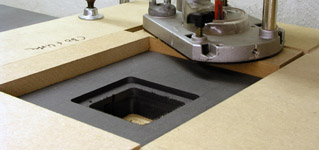
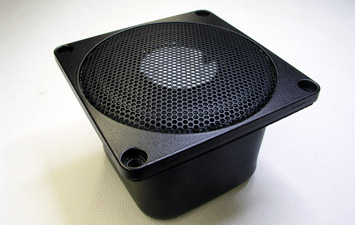
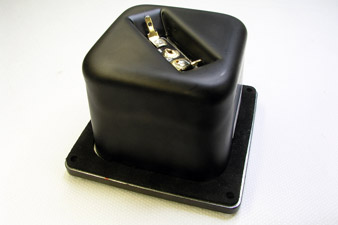
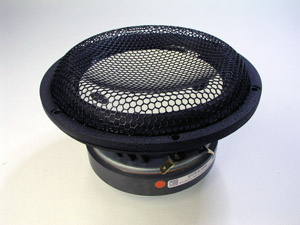
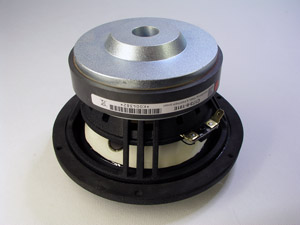
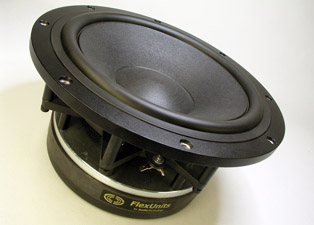
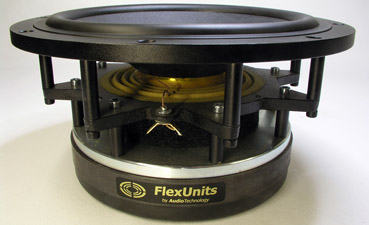
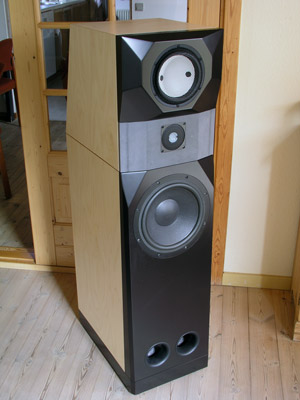
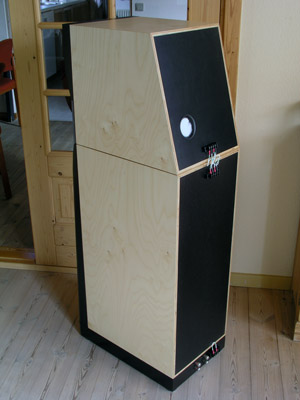
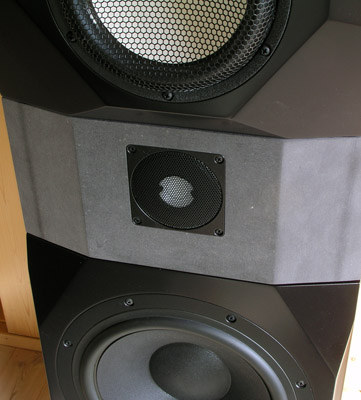
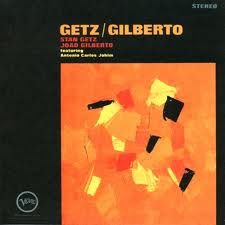
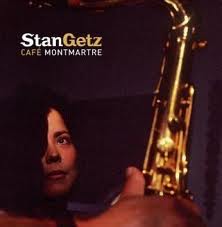
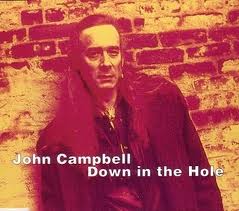
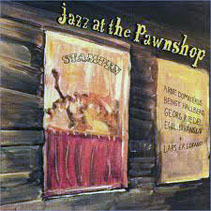
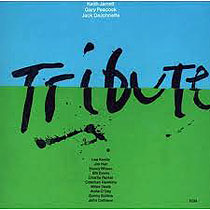
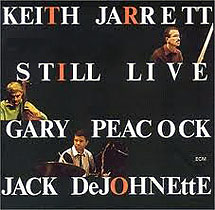
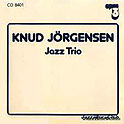
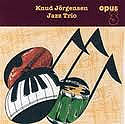
.jpg)
.jpg)
.jpg)
.jpg)
